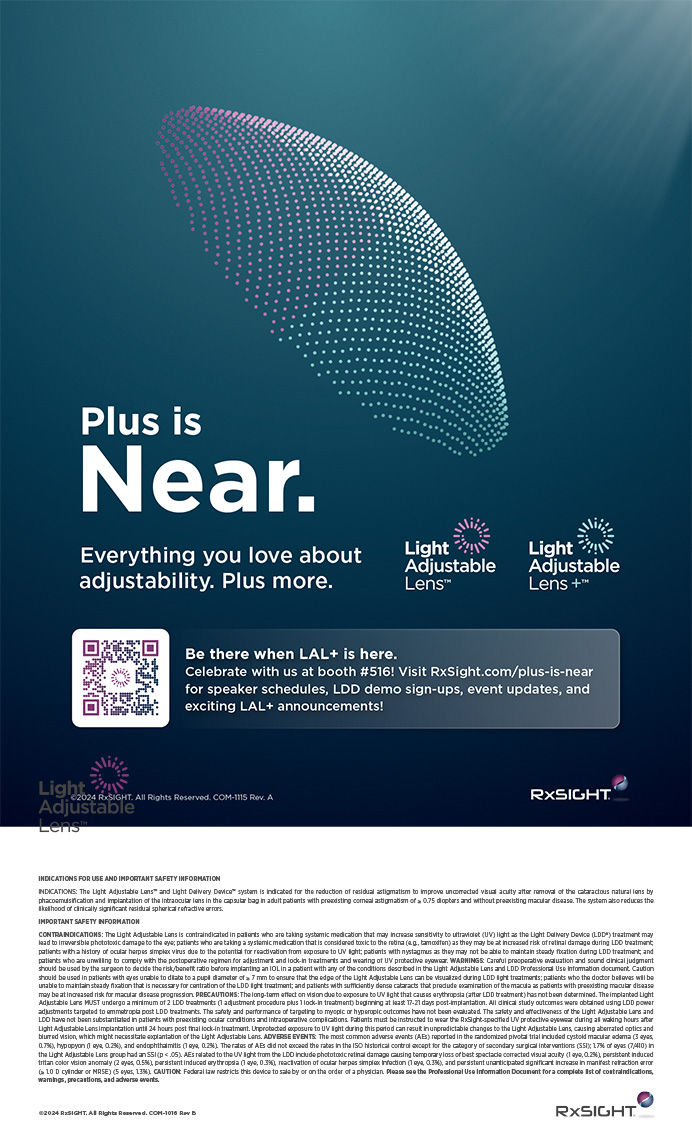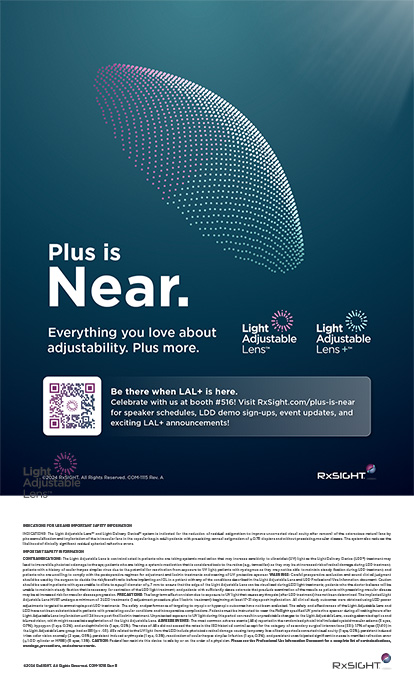My phone rang on a Thursday afternoon. Sixteen days earlier, a 60-year-old man had sustained a blunt injury to his left eye with a golf ball. A hyphema ensued, and the referring ophthalmologist noted subluxation of the lens. Medical management quieted the inflammation, but the patient urgently reappeared at his referring ophthalmologist’s office with eye pain and increased IOP. The referring physician observed anterior movement of the lens, and maximal topical, oral, and intravenous (IV) medications failed to yield an adequate response. My phone call to the patient’s home was returned when he got back from the emergency department, where IV hyperosmotics similarly failed.
TROUBLE FLIES IN
Courtesy of a generous friend with a jet, the patient rapidly flew 500 miles to arrive at the Cincinnati Eye Institute for an urgent consultation. Upon arrival, his visual acuity was count fingers, and the IOP measured 57 mm Hg on Combigan (Allergan, Inc.), Diamox (Duramed Pharmaceuticals Inc.), and atropine. Additional IV hyperosmotics produced an IOP of 62 mm Hg. An examination disclosed a loss of at least 8 clock hours of zonules. The markedly temporally subluxated cataractous lens and the mydriatic iris were appositional to the corneal endothelium. The aphakic nasal pupillary space was filled by the intact, prolapsed hyaloid face, thereby inducing a vitreo-lenticular pupillary block. Minutes later, the OR staff swung into action.
PUPILLARY BLOCK GLAUCOMA
After the patient was in the OR and prepped for surgery, I created a pars plana incision with a 25-gauge trocar and cannula and then placed a vitrector. With anterior infusion provided by a 21-gauge butterfly needle through a paracentesis, I opened the hyaloid face and performed a limited vitrectomy. The anterior chamber immediately deepened, the globe softened, and the lens fell back into its native plane … and kept on going (Figure 1). It was now readily apparent that only 1 to 2 clock hours of temporal zonules remained, the nasal lens equator pointing posteriorly from the residual temporal zonules.
WHAT GOES DOWN MUST COME UP
I carefully cleared all anterior vitreous gel from around the lens before creating a pars plana incision in the meridian of the remaining temporal zonules. Instilling copious amounts of Viscoat (Alcon Laboratories, Inc., Fort Worth, TX) through this opening into the vitreous cavity, just behind the lens, gently tilted the lens forward, back into the iris plane.
A futile attempt at piercing the anterior capsule with a cystotome effectively pushed the lens down into its Viscoat cushion. The ophthalmic viscosurgical device (OVD) was aspirated from the anterior chamber and again added through the pars plana. This time, I used the crossed-swords, capsule-pinch technique to open the anterior capsule between the opposing tips of two tangentially oriented 30-gauge needles (Figure 2). The capsulorhexis was facilitated by a 25-gauge forceps (MaxGrip DSP; Alcon Laboratories, Inc.), used both for peeling the continuous curvilinear capsulorhexis (CCC) tear and gently lifting the lens forward. As I created the capsulorhexis, I placed serial flexible retractors under the existing portion of the CCC to help stabilize the lens.
After the CCC’s completion, the bag was further stabilized by a type 6E Ahmed Capsular Tension Segment (CTS; Morcher GmbH, Stuttgart, Germany; distributed in the United States by FCI Ophthalmics, Inc., Marshfield Hills, MA). I inserted the device into the fornix of the capsular bag and tethered it to the limbus by placing a retractor through the fixation-element eyelet. Next, I emulsified the lens nucleus in a stepwise fashion using a phaco chop technique. After the removal of each section of lens material, I re-expanded the fornix of the bag with Viscoat to prevent the inadvertent aspiration of the equator of the bag. With the I/A device, I removed the cortical material in a similar fashion such that I separated it from the bag by viscodissection before stripping.
THE HOME STRETCH?
I injected an AcrySof IQ Restor IOL (Alcon Laboratories, Inc.) into the bag. I then fine-tuned the tension on the two Gore-Tex knots to maximize the IOL’s centration. The OVD in the anterior chamber was aspirated.
UH-OH
Indirect ophthalmoscopy showed a healthy posterior pole. Interestingly, a serous-appearing choroidal detachment was visible in the temporal periphery overlying the sclerotomy used for the OVD’s instillation. Overpressurization of the globe and burping of the scleral dissection allowed the OVD to escape from this orifice, reducing the elevation.
THE END
The postoperative course required maximal medical therapy to manage the IOP but was ultimately tapered down to two agents only. Glare from a residual 6-mm mydriatic pupil was addressed by cerclage 4 months later, yielding an excellent 20/25 result with no photophobia.
This case presented a wide combination of challenges at each stage, starting with the patient’s initial injury. Further, it demonstrated to me the versatility of capsular tension rings and segments in preserving the native capsular complex, even when zonular weakness is profound. This allows maximal anatomical and visual results, including a greater flexibility in IOL choices.
Indirect ophthalmoscopy after complex manipulations of the anterior segment or vitreous, as required in this case, allowed remediation of an unexpected challenge, which might have led to an osmotic gradient and an enlarging serous choroidal detachment, had it not been recognized in the OR.
I was able to achieve a happy result for this patient, thanks to the combined and coordinated efforts of the referring ophthalmologist, the patient, his friend, the clinical and surgery center teams at the Cincinnati Eye Institute, and, of course, the multitude of ophthalmologists and engineers responsible for developing the techniques, equipment, and devices needed. This case certainly emphasizes the team effort and attitude required for complex and particularly urgent scenarios.
Section Editor David F. Chang, MD, is a clinical professor at the University of California, San Francisco. Dr. Chang may be reached at (650) 948-9123; dceye@earthlink.net.
Michael E. Snyder, MD, is in private practice at the Cincinnati Eye Institute and is a voluntary assistant professor of ophthalmology at the University of Cincinnati. He is a consultant to Alcon Laboratories, Inc.; Haag-Streit AG; HumanOptics AG; and MicroSurgical Technology. Dr. Snyder may be reached at (513) 984-5133; msnyder@cincinnatieye.com.


